Barotropic Model¶
Here will will use pyqg to reproduce the results of the paper: J. C. Mcwilliams (1984). The emergence of isolated coherent vortices in turbulent flow. Journal of Fluid Mechanics, 146, pp 21-43 doi:10.1017/S0022112084001750
[23]:
import numpy as np
import matplotlib.pyplot as plt
%matplotlib inline
import pyqg
McWilliams performed freely-evolving 2D turbulence (\(R_d = \infty\), \(\beta =0\)) experiments on a \(2\pi\times 2\pi\) periodic box.
[24]:
# create the model object
m = pyqg.BTModel(L=2.*np.pi, nx=256,
beta=0., H=1., rek=0., rd=None,
tmax=40, dt=0.001, taveint=1,
ntd=4)
# in this example we used ntd=4, four threads
# if your machine has more (or fewer) cores available, you could try changing it
Initial condition¶
The initial condition is random, with a prescribed spectrum
where \(\kappa\) is the wavenumber magnitude. The constant A is determined so that the initial energy is \(KE = 0.5\).
[3]:
# generate McWilliams 84 IC condition
fk = m.wv != 0
ckappa = np.zeros_like(m.wv2)
ckappa[fk] = np.sqrt( m.wv2[fk]*(1. + (m.wv2[fk]/36.)**2) )**-1
nhx,nhy = m.wv2.shape
Pi_hat = np.random.randn(nhx,nhy)*ckappa +1j*np.random.randn(nhx,nhy)*ckappa
Pi = m.ifft( Pi_hat[np.newaxis,:,:] )
Pi = Pi - Pi.mean()
Pi_hat = m.fft( Pi )
KEaux = m.spec_var( m.wv*Pi_hat )
pih = ( Pi_hat/np.sqrt(KEaux) )
qih = -m.wv2*pih
qi = m.ifft(qih)
[4]:
# initialize the model with that initial condition
m.set_q(qi)
[5]:
# define a quick function for plotting and visualize the initial condition
def plot_q(m, qmax=40):
fig, ax = plt.subplots()
pc = ax.pcolormesh(m.x,m.y,m.q.squeeze(), cmap='RdBu_r')
pc.set_clim([-qmax, qmax])
ax.set_xlim([0, 2*np.pi])
ax.set_ylim([0, 2*np.pi]);
ax.set_aspect(1)
plt.colorbar(pc)
plt.title('Time = %g' % m.t)
plt.show()
plot_q(m)
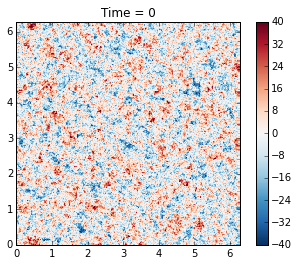
Runing the model¶
Here we demonstrate how to use the run_with_snapshots feature to periodically stop the model and perform some action (in this case, visualization).
[6]:
for _ in m.run_with_snapshots(tsnapstart=0, tsnapint=10):
plot_q(m)
t= 1, tc= 1000: cfl=0.104428, ke=0.496432737
t= 1, tc= 2000: cfl=0.110651, ke=0.495084591
t= 2, tc= 3000: cfl=0.101385, ke=0.494349348
t= 3, tc= 4000: cfl=0.113319, ke=0.493862801
t= 5, tc= 5000: cfl=0.112978, ke=0.493521035
t= 6, tc= 6000: cfl=0.101435, ke=0.493292057
t= 7, tc= 7000: cfl=0.092574, ke=0.493114415
t= 8, tc= 8000: cfl=0.096229, ke=0.492987232
t= 9, tc= 9000: cfl=0.097924, ke=0.492899499
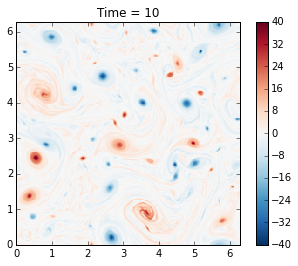
t= 9, tc= 10000: cfl=0.103278, ke=0.492830631
t= 10, tc= 11000: cfl=0.102686, ke=0.492775849
t= 11, tc= 12000: cfl=0.099865, ke=0.492726644
t= 12, tc= 13000: cfl=0.110933, ke=0.492679673
t= 13, tc= 14000: cfl=0.102899, ke=0.492648562
t= 14, tc= 15000: cfl=0.102052, ke=0.492622263
t= 15, tc= 16000: cfl=0.106399, ke=0.492595449
t= 16, tc= 17000: cfl=0.122508, ke=0.492569708
t= 17, tc= 18000: cfl=0.120618, ke=0.492507272
t= 19, tc= 19000: cfl=0.103734, ke=0.492474633
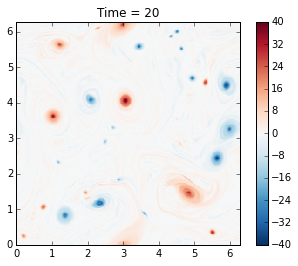
t= 20, tc= 20000: cfl=0.113210, ke=0.492452605
t= 21, tc= 21000: cfl=0.095246, ke=0.492439588
t= 22, tc= 22000: cfl=0.092449, ke=0.492429553
t= 23, tc= 23000: cfl=0.115412, ke=0.492419773
t= 24, tc= 24000: cfl=0.125958, ke=0.492407434
t= 25, tc= 25000: cfl=0.098588, ke=0.492396021
t= 26, tc= 26000: cfl=0.103689, ke=0.492387002
t= 27, tc= 27000: cfl=0.103893, ke=0.492379606
t= 28, tc= 28000: cfl=0.108417, ke=0.492371082
t= 29, tc= 29000: cfl=0.112969, ke=0.492361675
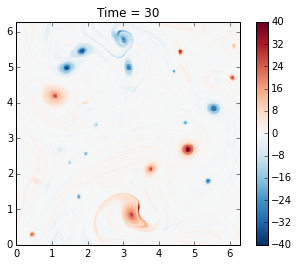
t= 30, tc= 30000: cfl=0.127132, ke=0.492352666
t= 31, tc= 31000: cfl=0.122900, ke=0.492331664
t= 32, tc= 32000: cfl=0.110486, ke=0.492317502
t= 33, tc= 33000: cfl=0.101901, ke=0.492302225
t= 34, tc= 34000: cfl=0.099996, ke=0.492294952
t= 35, tc= 35000: cfl=0.106513, ke=0.492290743
t= 36, tc= 36000: cfl=0.121426, ke=0.492286228
t= 37, tc= 37000: cfl=0.125573, ke=0.492283246
t= 38, tc= 38000: cfl=0.108975, ke=0.492280378
t= 38, tc= 39000: cfl=0.110105, ke=0.492278000
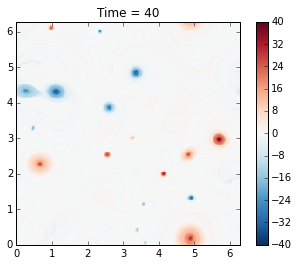
t= 39, tc= 40000: cfl=0.104794, ke=0.492275760
The genius of McWilliams (1984) was that he showed that the initial random vorticity field organizes itself into strong coherent vortices. This is true in significant part of the parameter space. This was previously suspected but unproven, mainly because people did not have computer resources to run the simulation long enough. Thirty years later we can perform such simulations in a couple of minutes on a laptop!
Also, note that the energy is nearly conserved, as it should be, and this is a nice test of the model.
Plotting spectra¶
[7]:
energy = m.get_diagnostic('KEspec')
enstrophy = m.get_diagnostic('Ensspec')
[11]:
# this makes it easy to calculate an isotropic spectrum
from pyqg import diagnostic_tools as tools
kr, energy_iso = tools.calc_ispec(m,energy.squeeze())
_, enstrophy_iso = tools.calc_ispec(m,enstrophy.squeeze())
[17]:
ks = np.array([3.,80])
es = 5*ks**-4
plt.loglog(kr,energy_iso)
plt.loglog(ks,es,'k--')
plt.text(2.5,.0001,r'$k^{-4}$',fontsize=20)
plt.ylim(1.e-10,1.e0)
plt.xlabel('wavenumber')
plt.title('Energy Spectrum')
[17]:
<matplotlib.text.Text at 0x10c1b1a90>
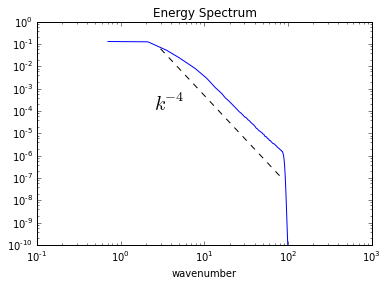
[20]:
ks = np.array([3.,80])
es = 5*ks**(-5./3)
plt.loglog(kr,enstrophy_iso)
plt.loglog(ks,es,'k--')
plt.text(5.5,.01,r'$k^{-5/3}$',fontsize=20)
plt.ylim(1.e-3,1.e0)
plt.xlabel('wavenumber')
plt.title('Enstrophy Spectrum')
[20]:
<matplotlib.text.Text at 0x10b5d2f50>
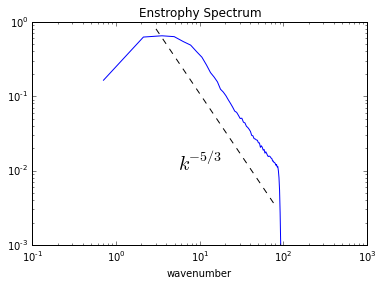
[ ]: